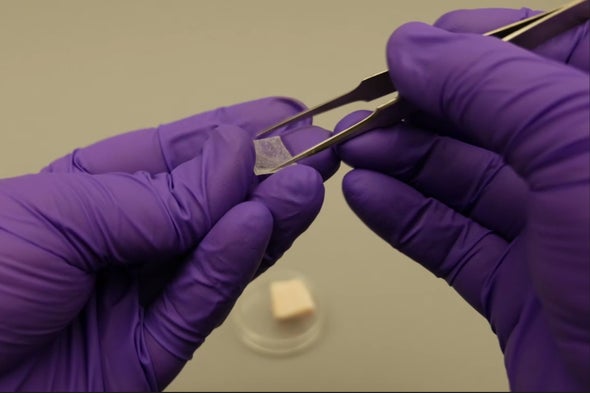Invisible Ink Could Reveal whether Kids Have Been Vaccinated
The technology embeds immunization records into a child’s skin
- By Karen Weintraub on

Researchers use microneedles to inject quantum dots with medical information into pig skin. Credit: Tom Buehler MIT Keeping track of vaccinations remains a major challenge in the developing world, and even in many developed countries, paperwork gets lost, and parents forget whether their child is up to date. Now a group of Massachusetts Institute of Technology researchers has developed a novel way to address this problem: embedding the record directly into the skin.
Along with the vaccine, a child would be injected with a bit of dye that is invisible to the naked eye but easily seen with a special cell-phone filter, combined with an app that shines near-infrared light onto the skin. The dye would be expected to last up to five years, according to tests on pig and rat skin and human skin in a dish.
The system—which has not yet been tested in children—would provide quick and easy access to vaccination history, avoid the risk of clerical errors, and add little to the cost or risk of the procedure, according to the study, published Wednesday in Science Translational Medicine.
“Especially in developing countries where medical records may not be as complete or as accessible, there can be value in having medical information directly associated with a person,” says Mark Prausnitz, a bioengineering professor at the Georgia Institute of Technology, who was not involved in the new study. Such a system of recording medical information must be extremely discreet and acceptable to the person whose health information is being recorded and his or her family, he says. “This, I think, is a pretty interesting way to accomplish those goals.”
The research, conducted by M.I.T. bioengineers Robert Langer and Ana Jaklenec and their colleagues, uses a patch of tiny needles called microneedles to provide an effective vaccination without a teeth-clenching jab. Microneedles are embedded in a Band-Aid-like device that is placed on the skin; a skilled nurse or technician is not required. Vaccines delivered with microneedles also may not need to be refrigerated, reducing both the cost and difficulty of delivery, Langer and Jaklenec say.



















